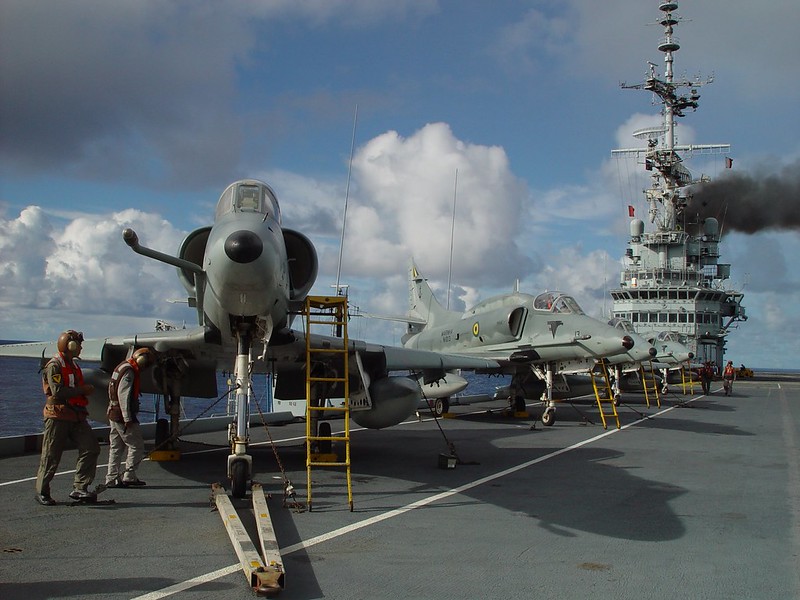The huge aircraft carrier that is roaming the Atlantic without anyone wanting it
Aircraft carriers are the largest ships in today's naval forces and are often a source of pride for their countries, until it is time for them to retire.
Few countries have been able to afford the luxury of building large aircraft carriers where conventional take-off and landing combat aircraft can land: the United States, the United Kingdom, the former USSR, communist China and France are the ones that make up that select club. In addition, there have been some countries that have operated these aircraft carriers after buying them already used: Argentina, Australia, Brazil and Canada. Today, none of these countries have aircraft carriers of this type still operational.

The aircraft carriers of the Brazilian Navy and the history of NAe São Paulo
The Brazilian Navy has operated two large aircraft carriers: the NAeL Minas Gerais A-11 (bought third-hand: previously it had been the British HMS Vengeance and the Australian HMAS Vengeance), which had been operated by Brazil since 1960 until 2001, and the NAe São Paulo A-12, formerly called Foch and bought second-hand from the French Navy in 2000. Launched in 1959, the NAe São Paulo is a of great size: she is 265 meters long and 51 meters wide, and her displacement is 27,300 tons. Brazil operated it with Douglas A-4 Skyhawk attack aircraft and Sea King, Super Puma and Ecureuil helicopters.

This aircraft carrier had a complicated operational life in the South American country. In May 2005, she suffered an explosion in her engine room, which caused three deaths, after which she had to undergo a repair and modernization process that lasted four years, returning to operation in August of 2010. The Brazilian Navy had great plans for this aircraft carrier, it was even launching a modernization and expansion of her air wing, but those plans were cut short in 2012 by another fire on board.

Again there was talk of submitting the ship to another repair and modernization process, but in 2017 the Brazilian Navy decided to withdraw it from service, alleging that the cost of repairs would be too high. In 2004, her predecessor, the NAeL Minas Gerais, had been taken to India to be scrapped, and now it was the turn of the NAe São Paulo. Her retirement from the Brazilian Navy took effect in 2018. Four years later, on August 4, 2022, the aircraft carrier began to be towed from Rio de Janeiro bound for Aliağa, Turkey, to be scrapped. The operation was commissioned by a Dutch tugboat.

Turkey does not want the NAe São Paulo in its ports: neither does Brazil
On August 26, the Turkish government denied the aircraft carrier an import license and issued a ban on accessing its ports, alleging that the Brazilian Navy had not submitted a report detailing the locations of asbestos and other materials. dangerous. The Maritime Executive pointed out that the Brazilian Navy had reported 9 tons of asbestos on the ship, but Turkey did not give credibility to the figure, since its sister ship, the Clemenceau, had 700 tons of asbestos on board. The NAe São Paulo had already arrived near the Moroccan coast, along the Strait of Gibraltar, but after receiving a return order from the Brazilian Institute of the Environment (IBAMA), on September 9 the ship turned around and He headed for Rio de Janeiro, where he hoped to arrive on October 2.

The misadventures of the aircraft carrier did not end there. Brazilian authorities denied their access to the ports of Brazil, for which reason the aircraft carrier was ordered to remain circling some 24 nautical miles from the coast. Finally, after a dispute between the Brazilian authorities and Sok, the company that had bought the ship for scrapping, last week the Brazilian Navy took over the aircraft carrier stating that it would not allow its access to their country's ports. So the ship continues to roam the Atlantic waters without anyone wanting it. Environmental groups have shown their fear that the Brazilian Navy will try to sink it in the middle of the ocean, using the excuse of a small leak in the structure of the boat.
Sinking of the NAe São Paulo
UPDATED 3.4.2022 6:32 p.m.: The Brazilian Navy reported yesterday the controlled sinking of the NAe São Paulo. At a press release (see PDF), it has been indicated that the ship was sunk in Brazilian jurisdictional waters, 350 km from the coast and at an approximate depth of 5,000 meters, in a location selected following the indications of the Navy Hydrography Center and the Almirante Paulo Moreira Institute of Sea Studies. "The analyzes considered aspects related to the safety of navigation and the environment, with special attention to the mitigation of impacts on public health, fishing activities and ecosystems", points to the note. At the moment, no images of the sinking have been released.
---
Foto principal: Marinha do Brasil. El NAe São Paulo A-12 en febrero de 2011, cuando estaba operativo.
|
Don't miss the news and content that interest you. Receive the free daily newsletter in your email: |
- Most read
- The 'hole' without civil flights around Paris during the opening of the Olympic Games
- Stunning footage of the F-15QA Ababil in flight recorded from its cockpit
- The firearms used by the Pontifical Swiss Guard, the smallest army in the world
- The most distant deployment of the Spanish Air Force in Australia and New Zealand
- Eurofighter vs F-35: the opinions of professional pilots on these advanced fighters
- The first photo of an F-16 fighter with Ukrainian insignia and the details it has revealed
- This is the driver station of an M1 Abrams tank and the impressive start of its engine

 ES
ES







Opina sobre esta entrada: